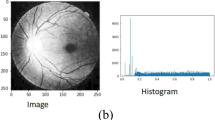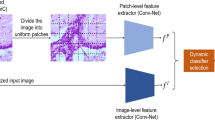Abstract
Histopathological image analysis of biopsy sample is the most reliable method for the detection and diagnosis of cancer. Automation in histopathological image analysis will help the pathologists to confirm their remarks with a second judgment. The proposed framework employs a CNN model with squeeze and excitation (SE) module based on hybrid squeezing method. In this approach, two levels of squeezing are provided for the feature maps using color-based spatial squeezing and channel-wise pooling. This squeezed weight adaptively scales each channel by boosting meaningful feature maps and diminishing less important features. The proposed CNN model is tested for the classification of histopathological images using Camelyon 16 and BreaKHis dataset. The experiments were conducted in four phases such as (i) CNN model without squeeze and excitation module (ii) CNN model with only channel pooling method (iii) CNN model with color-based spatial squeezing method (iv) CNN model with color-based spatial squeezing and channel pooling SE block. From the experimental results, the proposed model confirms better performance for histopathological image classification in terms of accuracy, precision, recall, F1 score and ROC. The computational load of the proposed model is also evaluated against regular CNN without SENet for obtaining the same evaluation metrics. The result shows the proposed model contributes 35% reduction in computational load in terms of trainable parameters. The performance of the proposed model is compared with state-of-the-art CNN methods and it is proved that the proposed model outperforms well in terms of evaluation metrics with very few numbers of model parameters.







Similar content being viewed by others
Data availability
Dataset is publicly available at https://github.com/basveeling/pcam. BreaKHisdatabase: https://web.inf.ufpr.br/vri/databases/breast-cancer-histopathological-database-breakhis/.
References
Bray, F., Laversanne, M., Weiderpass, E., Soerjomataram, I.: The ever-increasing importance of cancer as a leading cause of premature death worldwide. Cancer 127(16), 3029–3030 (2021). https://doi.org/10.1002/cncr.33587
Brown, M.V., et al.: Cancer detection and biopsy classification using concurrent histopathological and metabolomic analysis of core biopsies. Genome Med. 4(4), 33 (2012). https://doi.org/10.1186/gm332
Fischer, E.G.: Nuclear morphology and the biology of cancer cells. Acta Cytol. 64, 511–519 (2020). https://doi.org/10.1159/000508780
Kumar, R., Srivastava, R., Srivastava, S.: Detection and classification of cancer from microscopic biopsy images using clinically significant and biologically interpretable features. J. Med. Eng. 2015, 457906 (2015). https://doi.org/10.1155/2015/457906
Spanhol, F., de Oliveira, L.S., Petitjean, C., Heutte, L.: Breast cancer histopathological image classification using convolutional neural networks. (2016). https://doi.org/10.1109/IJCNN.2016.7727519.
Huang, K., Tian, C., Jingyong, S., Lin, J.C.-W.: Transformer-based cross reference network for video salient object detection. Pattern Recognit. Lett. 160, 122–127 (2022). https://doi.org/10.1016/j.patrec.2022.06.006
Sari, C.T., Gunduz-Demir, C.: Unsupervised feature extraction via deep learning for histopathological classification of colon tissue images. IEEE Trans. Med. Imaging 38(5), 1139–1149 (2019). https://doi.org/10.1109/TMI.2018.2879369
Tian, C., Yuan, Y., Zhang, S., Lin, C.-W., Zuo, W., Zhang, D.: Image super-resolution with an enhanced group convolutional neural network. Neural Netw. 153, 373 (2022)
Talo, M.: Automated classification of histopathology images using transfer learning. Artif. Intell. Med. 101, 101743 (2019). https://doi.org/10.1016/j.artmed.2019.101743
Spanhol, F.A., Oliveira L.S., Cavalin, P.R., Petitjean C., Heutte, L.: Deep features for breast cancer histopathological image classification. In: 2017 IEEE international conference on systems, man, and cybernetics (SMC), pp. 1868–1873. IEEE (2017)
Xiao, J., Xu, J., Tian, C., Han, P., You, L., Zhang, S.: A serial attention frame for multi-label waste bottle classification. Appl. Sci. 12, 1742 (2022). https://doi.org/10.3390/app12031742
Zhang, Q., Xiao, J., Tian, C., Chun-Wei-Lin, J., Zhang, S.: A robust deformed convolutional neural network (CNN) for image denoising. CAAI Trans. Intell. Technol. (2022). https://doi.org/10.1049/cit2.12110
Devassy, B.R., Antony, J.K.: Histopathological image classification using ensemble transfer learning. In: International conference on machine learning and big data analytics, pp. 203–212. Springer, Cham (2021)
Yang, Y., Wang, X., Sun, B., Zhao, Q.: Channel expansion convolutional network for image classification. IEEE Access 8, 178414–178424 (2020). https://doi.org/10.1109/ACCESS.2020.3027879
Li, X., Shen, X., Zhou, Y., Wang, X., Li, T.Q.: Classification of breast cancer histopathological images using interleaved DenseNet with SENet (IDSNet). PLoS ONE 15(5), e0232127 (2020). https://doi.org/10.1371/journal.pone.0232127
Hu, J., Shen, L., Sun, G.: Squeeze-and-excitation networks. In: 2018 IEEE/CVF conference on computer vision and pattern recognition, pp. 7132-7141 (2018). https://doi.org/10.1109/CVPR.2018.00745
Hu, J., Shen, L., Albanie, S., Sun, G., Wu, E.: Squeeze-and-excitation networks. IEEE Trans. Pattern Anal. Mach. Intell. 42(8), 2011–2023 (2020). https://doi.org/10.1109/TPAMI.2019.2913372
Szegedy, C., et al.: Going deeper with convolutions. In: 2015 IEEE conference on computer vision and pattern recognition (CVPR), pp. 1-9 (2015). https://doi.org/10.1109/CVPR.2015.7298594
Baba, A., Câtoi, C.: Comparative oncology. The Publishing House of the Romanian Academy, Bucharest Romania (2007)
Chong, S.M.: Image Processing 101. RecurseCenter Dynamsoft Corporation, NewYork (2019)
Hua, W., Zhang, Z., Suh, G.: Reverse engineering convolutional neural networks through side-channel information leaks. (2018). https://doi.org/10.1109/DAC.2018.8465773
Dubey, S.K.R.S.R., Chatterjee, S., Chaudhuri, B.: FuSENet: fused squeeze-and-excitation network for spectral-spatial hyperspectral image classification. IET Image Proc. 14, 4561 (2020). https://doi.org/10.1049/iet-ipr.2019.1462
Lin, M., Chen, Q., Yan, S.: Network in network. Neural and evolutionary computing. (2013). arXiv:1312.4400
Veeling, B.S., Linmans, J., Winkens, J., Cohen, T., Welling, M.: Rotation equivariant CNNs for digital pathology. arXiv [cs.CV] (2018). Available at http://arxiv.org/abs/1806.03962
Mehta, S., Lu, X., Weaver, D., Elmore, J., Hajishirzi, H., Shapiro, L.: HATNet: an end-to-end holistic attention network for diagnosis of breast biopsy images.
Srinidhi, C.L., Kim, S.W., Chen, F.-D., Martel, A.L.: Self-supervised driven consistency training for annotation efficient histopathology image analysis. Med. Image Anal. 75, 102256 (2022)
Acknowledgement
The authors would like to thank the anonymous referee for his/her comments which improved an earlier version of this work.
Funding
Not applicable.
Author information
Authors and Affiliations
Contributions
All authors made substantial contributions to the concept, design, and revision of the paper. We know of no conflicts of interest associated with this publication and we have contributed to this work.
Corresponding author
Ethics declarations
Conflict of interest
The authors declare no conflicts of interest.
Ethical approval
Not applicable.
Additional information
Publisher's Note
Springer Nature remains neutral with regard to jurisdictional claims in published maps and institutional affiliations.
Rights and permissions
Springer Nature or its licensor (e.g. a society or other partner) holds exclusive rights to this article under a publishing agreement with the author(s) or other rightsholder(s); author self-archiving of the accepted manuscript version of this article is solely governed by the terms of such publishing agreement and applicable law.
About this article
Cite this article
Devassy, B.R., Antony, J.K. Histopathological image classification using CNN with squeeze and excitation networks based on hybrid squeezing. SIViP 17, 3613–3621 (2023). https://doi.org/10.1007/s11760-023-02587-y
Received:
Revised:
Accepted:
Published:
Issue Date:
DOI: https://doi.org/10.1007/s11760-023-02587-y




